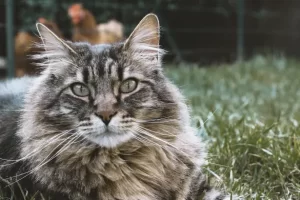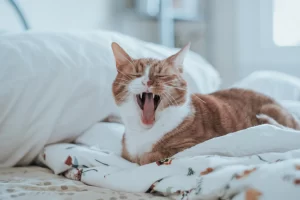Last updated on February 26th, 2023 at 01:14 am

Many people know cats are great at hunting rodents and other prey, but did you know these amazing little creatures also have an equally impressive defense mechanism? They have a special type of nail called a “claw,” which is sharper and more deadly than their teeth. With the help of their claws, cats can defend themselves against many potential threats. Cats use their claws for hunting, digging around and marking territory, and climbing up into trees. The cat’s claws are very sharp and can also be used to fight with other cats. In this article, we’ll know whether cats shed their claws. Keep reading to the end for tips on how to trim and take care of your cat’s claws.
Cat Claws 101
Cat claws are a very important part of a cat’s anatomy and behavior. Cats have retractable claws, which means they can extend them when needed, and retract them when not in use. Claws are a very important part of a cat’s anatomy, as they are used to help the cat climb, catch prey, defend itself, and groom itself.
A cat’s claws are made up of two parts: the inner root and the outer sheath. The inner root is the part of the claw that attaches to the bone inside the paw. It is made of a spongy material that is filled with nerves, blood vessels, and connective tissue. The outer sheath is the part of the claw that you see. It is made of keratin and is very hard and sharp. Cats have four toes on each paw and each toe has a claw. Most cats will have 18 claws, though it is possible for cats to have more or less depending on their breed and genetics. Cats will naturally sharpen their claws by scratching them against objects such as trees, furniture, and scratching posts. By doing this, cats are able to keep their claws sharp and in good condition.
Do Cats Shed Their Claws?
Cats do shed their claws, although not in the same way that other animals shed their fur or feathers. Feline claws are made of keratin, the same material that makes up human hair and fingernails. This means that cats don’t actually lose their claws like other animals, but rather the claws are constantly being worn down and replaced with new ones.
It is a common misconception that cats shed their claws as part of their regular grooming routine. The truth is that cats naturally shed their claws as they grow. This process is known as ‘claw sheathing’, and it occurs as the claws are replaced with new ones. As the new claws grow, the old ones are pushed out, leaving the cat with sharp, freshly cut claws. It is essential for cats to have sharp claws, as they are used for hunting and self-defense. Claws also help the cat to climb and balance. When a cat’s claws become too long, they can cause discomfort and can even snag on carpets and furniture. This is why it is important to keep an eye on your cat’s claws and trim them regularly.
Cats with injury to the paw may show similar signs, such as swelling and pain. In some cases, the front paw can become badly infected; this is more common in cats that are kept outside without access to water. The infection may spread through the nerves and lead to a painful toe or even grow deep enough to cause amputation of the toe.
How Often Do Cats Shed Their Claws?
According to Dr Smith, a cat’s claw will fall off every two to three months. A cat’s feet comprise 18 toes (some have more than that). This indicates that the cat will lose a sheath from each of its 18 claws within a period ranging from two to three months. You might anticipate many cat claws around the house if the feline never goes outside. If you are clipping your cat’s claws regularly, you may never notice them because they are so small.
If your cat uses a scratching post or other designated area to scratch, it actively tries to shed the nail sheaths currently covering its claws. The cat will use objects like these to scratch on to get the sheaths off its front claws to groom itself adequately. The cat will typically remove the sheaths from the claws on its rear paws by biting and chewing on them, as well as tugging the sheath off to expose the new claws underneath. Your cat is not wearing down its claws by clawing them out; instead, it is just shedding its old claw sheaths in a natural and instinctual manner that occurs every day.
Why Doesn’t My Cat Shed Its Claws When It Should?
The majority of cats lose their claws whenever they scratch something. Your cat may have trouble shedding its claws because it scratches less frequently. Sheaths can lead to overgrowth, resulting in complications such as infection and pain if not removed. Nails become thicker as cats age, and they may have less energy to scrape the protective sheaths off their nails. When a cat is sick, it could also have trouble using its claws as it usually would.
In addition, polydactyl cats have an extra toenail that does not have the ligaments that would ordinarily allow it to expand, scratch, or shed. To prevent the toenail from becoming overgrown, it is occasionally necessary to trim it. If your cat’s claws don’t shed, they will continue to develop and eventually curl. This is a normal part of the process. Because of this, they will develop into problematic paw pads, resulting in unnecessary agony for your cat.
How and Should I Trim My Cat’s Claws?
Trimming your cat’s claws is an important part of cat ownership. The process keeps your cat’s nails short and prevents them from getting too long and sharp. It also helps prevent your cat from getting snagged or caught on objects, which can lead to injury. Properly trimming your cat’s claws also helps to keep your furniture and other items safe from scratches.
Before you trim your cat’s claws, it’s important to make sure that your cat is comfortable and relaxed. If your cat is nervous or agitated, it is best to wait until they are calm before attempting to trim their claws. Giving your cat treats or petting them can help to relax them. If your cat is particularly nervous, it may be best to seek the help of a professional groomer or veterinarian. Once your cat is relaxed, it’s time to begin the trimming process. Start by gently holding one of your cat’s paws in your hand. Gently press down on the top of the paw to extend the nail. You should be able to see a white line at the base of the nail.
Cats with too long or poorly developed claws risk injury or pain from walking around with them incorrectly. The next thing that could cause a cat to shed its claws is an illness, such as diabetes or arthritis, when the cat cannot use its claws for scratching and grooming.
Since cats have unique anatomy, they do not do well with regular dog nail clippers or human nail clippers that cut at an angle. You may damage your cat’s claws by trying to trim them with these tools. The best bet is to get custom-made clippers meant for cats and tailored specifically for the species. Before you begin, you must be sure that your cat has never had its claws cut before. If it has, you could seriously injure it.
How to Take Care of your Cat’s Claws?
A cat’s nails grow as a result of the process of keratinization. This process occurs naturally but can also be accelerated by the activity in which a cat uses its claws. You must monitor your cat’s claws to trim them regularly. You should check for growing claws when cleaning your cat’s ears or fur or brushing your feline companion. You can check your cat’s claws by gently lifting its foot.
If you see the keratinisation process progress, it is time to clip your cat’s claws. Some people use scissors and cut the sharp part off their pet’s nails. The most common tool for claw clipping is a pair of clippers.
Use a proper pair of clippers and press them against each claw. Make sure you cut the claws in the right direction without cutting them off too short or too long. If you take your pet to a professional groomer, nothing will be easier than cutting their nails. Sometimes, bringing your cat to a grooming salon is better than trimming its claws at home.
Is it Difficult to Trim a Cat’s Nails?
Trimming your cat’s nails can be a challenging task for some cat owners. Fortunately, with a little bit of practice and patience, it can be done with relative ease. When it comes to trimming a cat’s nails, you want to make sure that you are prepared, that you have the right tools, and that you are gentle and patient.
The first step to trimming your cat’s nails is to make sure you have the right tools. You will need a sharp pair of nail clippers specifically designed for cats, as well as styptic powder or cornstarch (in case of accidental bleeding). Once you have the right tools, you need to make sure that your cat is comfortable and relaxed. This may mean petting and comforting your cat while you are trimming their nails or offering treats as rewards.
The next step is to get a good look at your cat’s nails. You want to make sure that you are not cutting too close to the quick (the pink area under the nail), as this can cause pain and bleeding. Soft paws are little rubber grips that you can buy at your local pet supply store. They must fit your pet perfectly because it could be dangerous for him if the grip does not fit well. These caps will make it easier to trim your cat’s nails and help manipulate them to keep your cat calm and make it more pleasant to work with its claws. If you are unsure of how to trim your cat’s nails, you can always ask your veterinarian for assistance.
Conclusion
When you trim a cat’s claws, you should avoid cutting them too short or too long. If you cut them too short, they may stop growing, but if you cut them too long, they will grow back even longer than they were before. If you allow your kitty to walk on tile or hardwood floors at home, it is best not to keep its claws long. Grooming your cat is important for the health of both of you. In addition, it will help frequently remind you of the fun companionship you share with your pet.


